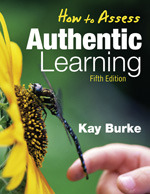How to Assess Authentic Learning
- Kay Burke - Kay Burke & Associates, Inc.
"Burke has challenged teachers everywhere to raise their standards and design classroom assessments that show evidence of understanding and performance on complex tasks. The expert examples in this book provide teachers with a complete road map so that assessment is truly at the heart of instruction."
—Diane Ray, Assistant Director for Teacher Leader Development
Professional Association of Georgia Educators
Create assessments that meet state standards and target students' learning needs!
For many years, assessment was relegated to a secondary role in the educational process. But with the increased emphasis on high-stakes testing, effective assessment has emerged as one of the major factors in raising student achievement.
In this latest edition of her bestseller, renowned educator Kay Burke provides a wide range of updated, easy-to-implement alternative assessments that address today's accountability requirements and focus on improving learning. Designed for use across all content areas, these formative assessments are rooted in the language of state standards and emphasize differentiating instruction to meet students' individual learning needs. Revised throughout with updated research, this new edition helps K–12 teachers:
- Build Response to Intervention checklists for struggling students
- Develop unit plans using differentiated learning and assessment strategies
- Create portfolios that emphasize metacognition
- Design performance tasks that motivate and engage students
- Construct rubrics that describe indicators of quality work
- Create tests that focus on higher-order thinking skills
Offering numerous applications and examples, How to Assess Authentic Learning guides teachers in developing the assessment tools needed to help all students meet or exceed mandated academic standards.
Register for Kay Burke's CE course on Effective Assessment here.
"Burke has challenged teachers everywhere to raise their standards and design classroom assessments that show evidence of understanding and performance on complex tasks. The expert examples in this book provide teachers a complete road map so that assessment is truly at the heart of instruction."
"An important text. Classroom teachers will find the descriptions and examples very doable and extremely helpful."
"This book will certainly appeal to educators across the nation. The abundance of research and examples will certainly benefit and motivate teachers and administrators."
"This is the type of text that teachers will keep so that they can reference it in the future."
"There is a great deal of practical, useful information that teachers will find valuable."
"A powerful tool with classroom-ready examples that demonstrate sound and valuable assessment practices. It’s a phenomenal resource."
great resource for per-service teachers
It presents clear information about authentic assessment instruments. This is a core content of the assessment courses provided to education students at our university. This book has been adopted as recommended textbooks for course EDUC 355.
Text doesn't contain enough research into best practices in order to help teachers realize what they need to do to improve student achievement. Provides only an overview of several topics without enough depth into any of them.
The author revised and reorganized the fifth edition on a structural level, combining, splitting, and eliminating several chapters from the previous edition. As a result, the book was streamlined into 9 chapters that are often longer and more in-depth. Topics such as creating tests and assessing tests, for example, have been split into their own respective chapters.
These new sections and subsections included additional material as well as new examples and references to add to previous discussion of certain topics. For instance, the author added many new practical examples of performance tasks that can be used in the classroom. She also expanded on learning logs and journals—describing their similarities and differences and explaining how to effectively use them with students—as well as on assessment tools such as rubrics, further splitting them into groups such as generalized, analytical, and weighted.
At the end of each chapter the author added a "Final Thoughts" section to concisely sum up and tie together the main concepts introduced in the chapter. Additionally she has added several "Resources" to the back of the book to be considered for classroom activities performance tasks.
